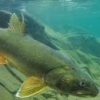
Native(s) for a 10 gallon
#22

Posted 11 April 2014 - 08:34 PM
1. (I'm assuming I can put it next to my stove if I do pygmies so...) Go buy a 10 gallon, sand, an air stone, and hornwort.
2. Setup the tank and let run for a few days.
3. Add 3 Pygmy Sunfish.
4. Feed the fish twice a day and do water changes whenever nitrates hit 20 ppm. Lights will be on approx 6 hours a day (2:50-9:00 PM)
5. Sit back and enjoy some beautiful natives. And hopefully get some nice spawns
Tank Statistics:
Lights: 6/24 Hours + Natural/Ambient Light
Feeding: Either frozen Brine Shrimp or Bloodworms twice a day
Temperature: 66-82 F
pH: 7.6
Substrate: Sand
Filter: No mechanical filtration, just plants.
Do you guys approve of this plan before I go through with it?
#23
 Guest_Erica Lyons_*
Guest_Erica Lyons_*
Posted 11 April 2014 - 09:02 PM
Hornwort runs out of nitrate, dies of starvation.
Baby production zero or near zero due to parents staying in same tank.
Stagnant water gets problems such as bacteria, fungus, etc. I use some sort of water flow in all my deep tanks (air stone, waterfall filter, any water movement). A standard shaped 10 gallon has pockets too deep to exchange with the surface gas and needs water movement.
#24

Posted 12 April 2014 - 05:23 PM
Potential problems:
Hornwort runs out of nitrate, dies of starvation.
Baby production zero or near zero due to parents staying in same tank.
Stagnant water gets problems such as bacteria, fungus, etc. I use some sort of water flow in all my deep tanks (air stone, waterfall filter, any water movement). A standard shaped 10 gallon has pockets too deep to exchange with the surface gas and needs water movement.
Ok then I'll add hornwort later, what plant should I star with then (preferably native to the pygmy es habitat)?
I'm not worried much about fry, I've heard multiple experiences and really I'll just be glad to get a few every once in a while, not looking for a money racket. I did say in my last post that the water would not be stagnant since I'm purchasing an air stone.
#25
 Guest_Erica Lyons_*
Guest_Erica Lyons_*
Posted 12 April 2014 - 05:38 PM
If you go with a rooted plant that can get its nitrogen from the ground, you don't have to worry about keeping water column nitrate above 0 ppm. Here's a guide to some of the plants of Florida: http://myfwc.com/med...tidentifier.pdf Here's a second. http://plants.ifas.u...ry?filter0[]=13 That's just a small fraction of the plants found in Florida. As to where to buy them, aquabid.com has hundreds of species of plants. You can google search the name to find the origin.
My elassoma gilberti tank eventually had zero fish in it because of a period of about one year with no fry production. They do not have long life spans. Mine did not produce any fry with the parents in the tank, not any.
Reply to this topic
0 user(s) are reading this topic
0 members, 0 guests, 0 anonymous users







